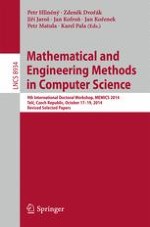2014 | Book
Mathematical and Engineering Methods in Computer Science
9th International Doctoral Workshop, MEMICS 2014, Telč, Czech Republic, October 17--19, 2014, Revised Selected Papers
Editors: Petr Hliněný, Zdeněk Dvořák, Jiří Jaroš, Jan Kofroň, Jan Kořenek, Petr Matula, Karel Pala
Publisher: Springer International Publishing
Book Series : Lecture Notes in Computer Science
